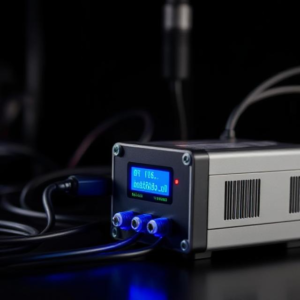What is a Power Converter?
A power converter is an electronic device that changes the form of electrical power to suit the needs of a system. For example, if you have a device that runs on a specific voltage, a power converter will change the input power (from a wall socket or a battery) to the correct output power your device needs.
There are two main types of power conversion:
- AC to DC conversion (from Alternating Current to Direct Current), like how you charge your phone.
- DC to AC conversion (from Direct Current to Alternating Current), used in systems like inverters for solar panels.
But high-efficiency power converters are special. They are designed to convert electrical power with as little loss as possible—so they waste less energy and keep everything running more smoothly.

Why is Efficiency Important in Power Converters?
When a power converter works, it usually transforms electrical power from one form to another. However, no system is 100% perfect, so some energy gets lost as heat. For example, a low-efficiency converter might waste a lot of energy during the process, making it less efficient.
High-efficiency power converters are designed to minimize this wasted energy, meaning they can provide more of the power you need without losing much. This is especially important in systems where energy cost and battery life are important, like in solar systems, electric cars, or portable devices.
How Do High-Efficiency Power Converters Work?
High-efficiency power converters use advanced designs and technologies to minimize energy loss. Some key technologies and techniques include:
- Switching Technology:
- Power converters often use switching technology, which rapidly turns the power on and off. By switching the power on and off at a high frequency (very fast), they reduce the loss compared to older methods like linear regulation.
- Switch-mode power supplies (SMPS) are an example of this technique, and they are much more efficient than older linear regulators.
- Pulse Width Modulation (PWM):
- PWM is a technique used to control how long the power is on and off. By carefully controlling the “on” and “off” times, the converter can adjust the output voltage or current while keeping losses low.
- Think of it like a light dimmer: instead of lowering the power directly, PWM controls how long the light stays on, which helps save energy.
- Advanced Components (like MOSFETs):
- Modern high-efficiency converters use MOSFETs (metal-oxide-semiconductor field-effect transistors) or GaN transistors (gallium nitride transistors), which are much faster and can handle more power with less heat compared to older components. These components help make the power conversion process faster and more efficient.
- Heat Management:
- In power converters, less heat means better efficiency. High-efficiency designs often include ways to dissipate heat effectively so that the system doesn’t waste energy as heat.
- This can involve using special heat sinks, cool materials, or smart thermal management systems to keep the converter running at optimal temperatures.
Why is High Efficiency Important?
- Lower Energy Bills:
- High-efficiency power converters waste less energy, which translates to lower electricity costs. For example, in a large data center or factory, using efficient power converters can save a lot of energy over time.
- Longer Battery Life:
- In portable devices like laptops or smartphones, using a high-efficiency converter helps to extend battery life because it reduces how much power is lost during the conversion process. That way, more of the energy from the battery goes into running the device.
- Environmentally Friendly:
- Less energy waste means less carbon footprint. High-efficiency power converters help reduce the overall energy consumption and environmental impact of devices, which is great for sustainability.
- Smaller and Lighter Systems:
- Since high-efficiency power converters produce less heat and are more effective, they can often be made smaller and lighter, which is important for devices that need to be compact, like electric vehicles or mobile electronics.
Where Are High-Efficiency Power Converters Used?
- Solar Power Systems:
- Solar panels generate DC power, but many homes and businesses need AC power. High-efficiency power converters (called inverters) are used to convert the DC power from the solar panels into the AC power that can be used in homes and businesses.
- Electric Vehicles (EVs):
- EVs use DC batteries, but the motors typically require AC power. High-efficiency converters help to charge the battery, run the motor, and control energy flow with minimal losses.
- Computers and Servers:
- Computers and data centers need efficient power conversion to reduce energy use and heat. High-efficiency power converters are used in the power supplies of these systems to keep them running smoothly and save energy.
- Consumer Electronics:
- Devices like smartphones, laptops, and gaming consoles all use high-efficiency power converters to keep their battery life long and energy usage low.
Examples of High-Efficiency Power Converters:
- Buck Converters:
- A buck converter is a type of power converter that steps down voltage efficiently. It converts higher voltage to a lower voltage (for example, converting 12V to 5V) with very little energy loss.
- Boost Converters:
- A boost converter increases the voltage from a lower level to a higher level. For example, it can increase 5V to 12V. These are useful when you need to power devices that require higher voltage than the available power source.
- DC-AC Inverters:
- Inverters are used to convert DC power (like from a battery or solar panel) to AC power, which is commonly used in homes and businesses.
Summary:
A high-efficiency power converter is an electronic device designed to convert electrical power with as little waste as possible. They are used to:
- Change power from one type (AC to DC or DC to AC).
- Use switching technology, PWM, and advanced components to minimize energy loss.
- Help save energy, extend battery life, reduce environmental impact, and make devices smaller and lighter.
These converters are important in solar power, electric vehicles, consumer electronics, and many other applications.










